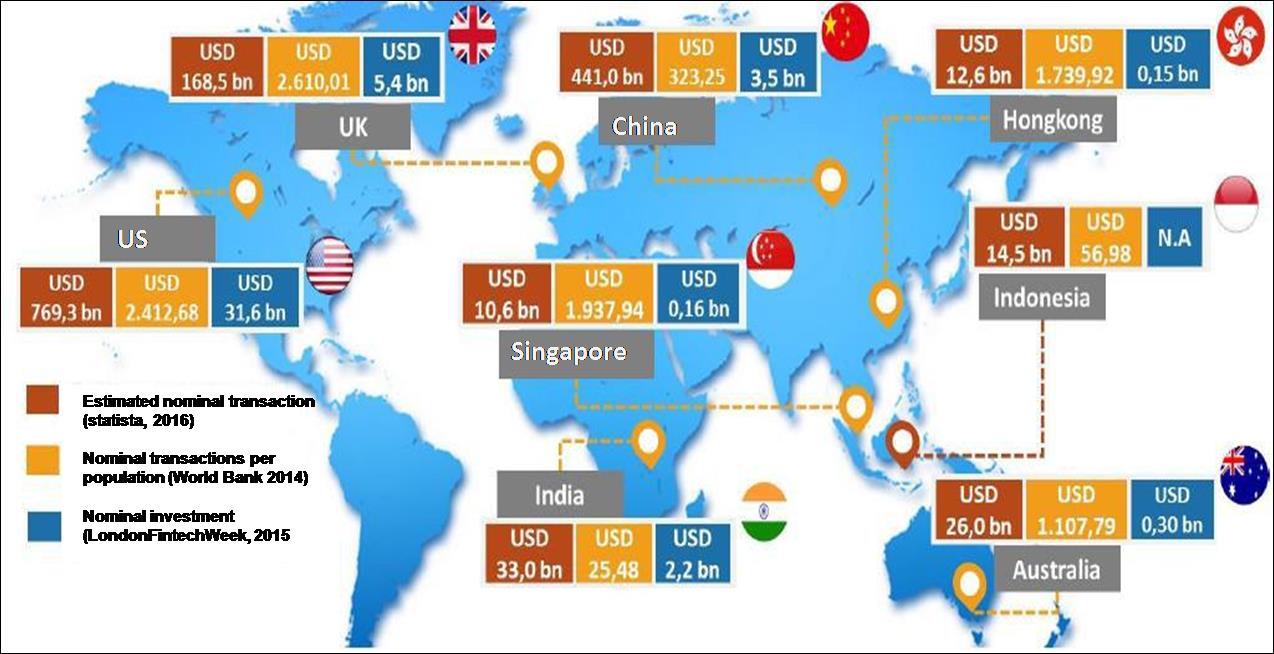- Strong growth recorded in investments into fintech companies in Asia fuelling future potential of the sector
- China has emerged as clear leader in Asia followed by India but markets like Indonesia are also poised for growth now
- Asian countries expand fintech in key financial services business areas such as payments and lending
The entry of fintech companies into the niche segments of mainstream financial services has challenged traditional banks through innovation, customer-centric services, and nimble systems. Successful fintechs have been providing highly focused and effective applications, managing to capture larger customer segments (and high valuations) through their unique products and services. They have also dramatically changed the way operations in the financial services industry are conducted.
At The Asian Banker Indonesia International Banking Convention held in July 2016, Muliaman Hadad, chairman of the Financial Services Authority of Indonesia or Otoritas Jasa Keuangan (OJK) noted three key reasons for the growth of information technology in the financial services industry.First, the shift in the behaviour of customers who lean towards digital services. The rapid use of financial technology has changed consumer preferences who favour ‘anytime’ and ‘anywhere’ types of transactions, especially through mobile channels. Second, there is a need to enhance financial access to reach the under-served segments while optimising the use of innovation to provide lower transaction fees. Lastly, potential customers from micro small and medium enterprises (MSME) segments were being denied from accessing certain banking services because of more stringent prudential standards for bank loans.He also announced that OJK will introduce new guidelines to encourage fintechs to operate in Indonesia.
Fintech investments in Asia quadrupled in 2015. China generated the largest share of fintech investments, followed by India. Relatively smaller markets like Singapore and Hong Kong have emerged as growth hubs because of their pro-fintech policies and government support. Now other markets like Indonesia are also gearing for potential growth.
Fuelling the fintech growth
Global investments are fuelling the growth of fintech companies, with the US and China emerging as front runners. Over the last three years, fintech financing has increased by over four times, indicating the financial health and perceived robust potential of this sector.
A research by Accenture showed that global fintech investments grew by 75% ($9.6 billion) to reach $22.3 billion in 2015.These investments comprise mainly financing provided by venture capital and private equity firms, corporations and corporate venture-capital divisions, hedge funds, accelerators, and government-backed funds. These investors have poured an unprecedented amount of money into global fintech start-ups.This was driven by a relatively moderate growth in the US fintech sector, which received $4.5 billion in new funding (44% increase); and the rapid growth in China’s fintech sector – which increased 445% to nearly $2 billion. Other key markets that witnessed strong growth in 2015 include India ($1.65 billion), Germany ($770 million), and Ireland ($631 million). Fintech investments in Asia Pacific quadrupled to $4.3 billion.
Funding of collaborative fintech ventures - which accounted for 38% of all fintech investment in 2010, grew to 44% of funding in 2015, with the remaining investments made in ventures that compete with financial institutions.
During the first quarter of 2016, financing increased 67% to $5.3 billion and the proportion of investments going to fintech companies in Europe and Asia Pacific nearly doubled to 62%. This growth in financing of fintech companies is rapidly fuelling the industry, particularly in certain geographies.
Changing fintech landscape in Asia
The US, China and UK have raced ahead in fintech capabilities while many Asian countries now look to gather pace. A Statista report on the value of worldwide fintech transactions in 49 countries in 2016 estimated that the US had the highest transactional value at $769 billion, followed by China ($441 billion), and UK ($169 billion). These figures refer to estimated transaction volumes (and not corporate revenue) covering digital payments, business finance, and personal finance. These include digital financial services and alternative finance instruments, digital payments transactions, marketplace lending (peer-to-peer platforms) for businesses and personal loans, robo-advisors and automated wealth management services, and online crowdfunding and venture financing.
Statista estimates that the total value of worldwide fintech transactions in 2016 is $2.36trillion, 91% of which ($2.16trillion) is from digital payments.
Figure 1. Value of worldwide fintech transactions

Source: Statista
Notes: Nominal transaction:Estimated fintech transactions in digital payment, personalfinance, business finance by Statista for 2016
Nominal transaction per population: Estimated fintech transactions in digital payment, personal finance, business finance over population by Statista 2016
Nominal investment: Investment into fintech from 2010-2015 as estimated by London Fintech Week, 2015
Globally, the US followed by China, emerge as leaders in fintech transactions. Fintech companies in China have been particularly successful due to a booming e-commerce market and the support provided by regulators. The country is believed to be the biggest peer-to-peer (P2P) lender and is home to the largest e-commerce companies in the world like Alibaba and Tencent.
While China is leading the rise of fintechs in the region, startups in other Asian countries are also keeping up, particularly in key financial services business areas such as payments and lending. Furthermore, China and India have high populations with notable technology adaption that make them opportune for fintech growth.
India is emerging as a fintech growth hotspot with notable government initiatives towards financial inclusion, which includes a biometric-enabled unique ID system and new unified payment initiatives. Reserve Bank of India (RBI) is setting up a multidisciplinary committee that will look at building ecosystem to promote the right fintechs. Start-Up India and Digital India are some of the notable government initiatives to promote the growth of technology in the country.
In Indonesia, OJK is actively planning measures to promote the growth of fintechs while providing the right guidelines to manage the potential risks and challenges. “A licensing mechanism needs to be put in place to ensure that we arrive at the true balance between growth and the stability of fintech and financial system as a whole. We are reviewing and improving guidelines. There will be a dedicated group in OJK that will be in-charge of fintech and innovation. The team will also monitor the trends and developments in financial technology; analyse and propose guidelines that can create a good balance to provide a room for the growth of the industry and taking into consideration stability and security,” Hadad explained.
“The development and utilisation of IT within the financial services industry and the presence of fintech will improve competitiveness and financial access, and deepen our financial market,” he added. OJK and other government agencies are also organising a fintech festival to increase awareness of people and access to new applications.
Nonetheless, there remains a strong need for financial inclusion in Indonesia. A Global Findex report in 2014 showed that only 36% of the adult population has financial accounts in formal financial institutions. However, almost half of the population own mobile phones and are online, which is equivalent to 2% or 139 million of the world’s total internet user. This highlights the potential to expand fintech models to facilitate higher financial inclusion.
Furthermore, government support in countries like Singapore, Hong Kong, and South Korea has significantly helped fintech companies to flourish. Following the tracks of the UK’s Financial Conduct Authority (FCA) and the Monetary Authority of Singapore (MAS), other regulators such as the OJK are considering plans to implement a ‘sandbox’ approach to promote fintech innovation. Sandbox creates a ‘safe space’ with relaxed regulatory environment where businesses can test innovative products, services, business models, and delivery mechanisms in a live environment.
Key focus segments
Investments are rapidly growing in certain focus segments where fintech have been more successful. Citi’s ‘Digital Disruption - How Fintech is Forcing Banking to a Tipping Point’ report showed that 70% of investments in private fintech companies were made in the area of personal finance and small and medium enterprises (SMEs) – the more profitable business segments where fintech companies hope to influence customers by offering innovative customer experience using smart phones.
Fintech companies are offering unique ideas and proposition that can solve business issues. Small start-ups, facilitated by mobile internet and smartphones, are revolutionising the face of banking. There are some key segments such as payments, P2P funding, analytics, and personal finance where fintech have emerged as more successful. Innovations are targeted at efficient real-time payments, reducing costs and changing the ways people access financial services and conduct financial transactions. Online P2P funding is changing the dynamics of traditional lending, which allows the funding of customer segments that previously were not targeted by banks.
Increasingly, fintech companies are also becoming visible in real-time cost effective remittances, data analytics insights, and next-generation robo-advisors. The new applications of artificial intelligence into financial services are also emerging. Experts are predicting greater use of algorithmic platforms and predictive analytics by ‘regtech’ to help large companies and banks with their regulatory and compliance technology needs.
There is a rise of well-funded fintech companies that can potentially break the dominance of banks in the financial service sector in certain business segments. In this scenario, survival necessitates that the banks rise to the technology challenge.
Leading banks are actively engaging innovation through multipronged strategies. Besides setting up their own innovation centres and building a tech culture through hackathons, supporting incubators, and accelerators; banks are actively partnering and collaborating with fintechs. This will help the financial services industry regain its dynamism, improve customer service, and experience while bringing new innovations.
































